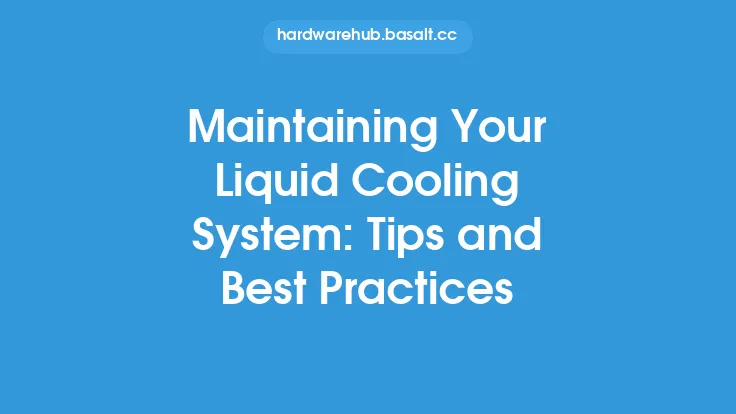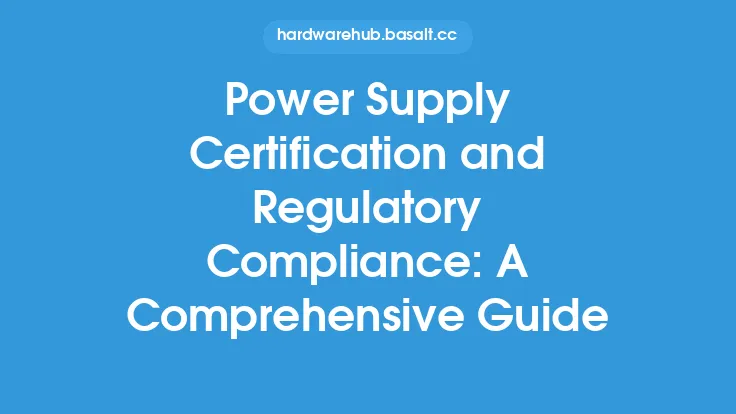When it comes to power supply efficiency, there are several factors to consider in order to maximize performance and minimize energy waste. Power supply efficiency refers to the ability of a power supply unit (PSU) to convert AC power from the mains to DC power for the computer's components, while minimizing energy loss in the form of heat. A high-efficiency power supply can help reduce energy consumption, lower electricity bills, and decrease the risk of overheating and component failure.
Understanding Power Supply Efficiency Metrics
To maximize power supply efficiency, it's essential to understand the various metrics used to measure performance. The most common metric is efficiency percentage, which represents the ratio of output power to input power. For example, an 80% efficient power supply will output 80 watts of DC power for every 100 watts of AC power drawn from the mains. Other important metrics include power factor (PF), which measures the ratio of real power to apparent power, and total harmonic distortion (THD), which measures the distortion of the AC waveform.
Choosing the Right Power Supply
Selecting the right power supply for your computer is critical to maximizing efficiency. Look for a power supply with a high efficiency rating, such as 80 PLUS Gold or higher, which indicates that the PSU meets certain efficiency standards. Additionally, consider the power supply's wattage and ensure it matches your system's power requirements. A power supply that is too large for your system can lead to inefficiencies and increased energy waste.
Optimizing Power Supply Configuration
Proper configuration of the power supply can also impact efficiency. Ensure that the power supply is properly connected to the motherboard and other components, and that all cables are securely fastened. Additionally, consider using a power supply with modular cabling, which allows you to remove unused cables and reduce clutter. This can help improve airflow and reduce the risk of overheating.
Cooling and Airflow
Cooling and airflow play a critical role in maintaining power supply efficiency. Ensure that the power supply is installed in a well-ventilated area, and that airflow is not restricted by nearby components or cables. Consider using a power supply with a built-in fan or a fanless design, which can help reduce noise and improve efficiency. Additionally, ensure that the power supply is kept clean and free of dust, which can accumulate and reduce efficiency over time.
Monitoring and Maintenance
Regular monitoring and maintenance can help ensure that the power supply operates at maximum efficiency. Use software tools to monitor power consumption and identify areas for improvement. Additionally, perform regular cleaning and maintenance tasks, such as dusting the power supply and checking for loose connections. This can help prevent overheating and component failure, and ensure that the power supply continues to operate at peak efficiency.
Advanced Power Supply Technologies
Several advanced power supply technologies can help maximize efficiency, including DC-to-DC conversion, synchronous rectification, and active power factor correction. DC-to-DC conversion involves converting the AC power to a stable DC voltage, which is then converted to the required voltage levels for the system's components. Synchronous rectification involves using high-speed switching transistors to rectify the AC power, which can help reduce energy loss and improve efficiency. Active power factor correction involves using a power factor correction circuit to regulate the power factor and improve efficiency.
Power Supply Efficiency in Different Applications
Power supply efficiency can vary depending on the application. For example, in desktop computers, power supply efficiency is critical to minimizing energy waste and reducing the risk of overheating. In data centers, power supply efficiency is essential to reducing energy consumption and minimizing the environmental impact of large-scale computing operations. In embedded systems, power supply efficiency is critical to minimizing power consumption and prolonging battery life.
Conclusion
Maximizing power supply efficiency requires a combination of proper selection, configuration, and maintenance. By understanding the various metrics used to measure performance, choosing the right power supply, optimizing configuration, and ensuring proper cooling and airflow, you can help minimize energy waste and reduce the risk of overheating and component failure. Additionally, staying up-to-date with advanced power supply technologies and considering the specific requirements of your application can help ensure that your power supply operates at maximum efficiency. By following these tips and best practices, you can help reduce energy consumption, lower electricity bills, and promote a more sustainable and environmentally friendly computing environment.





